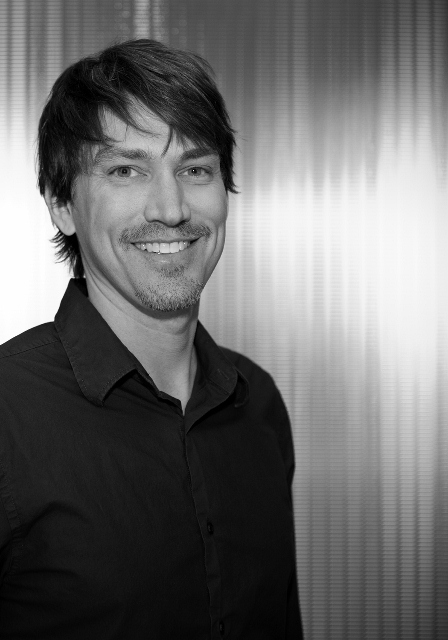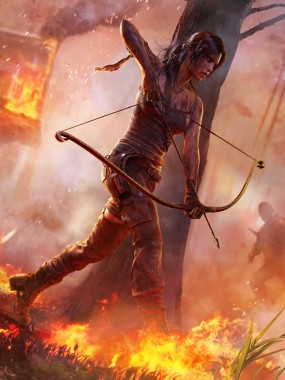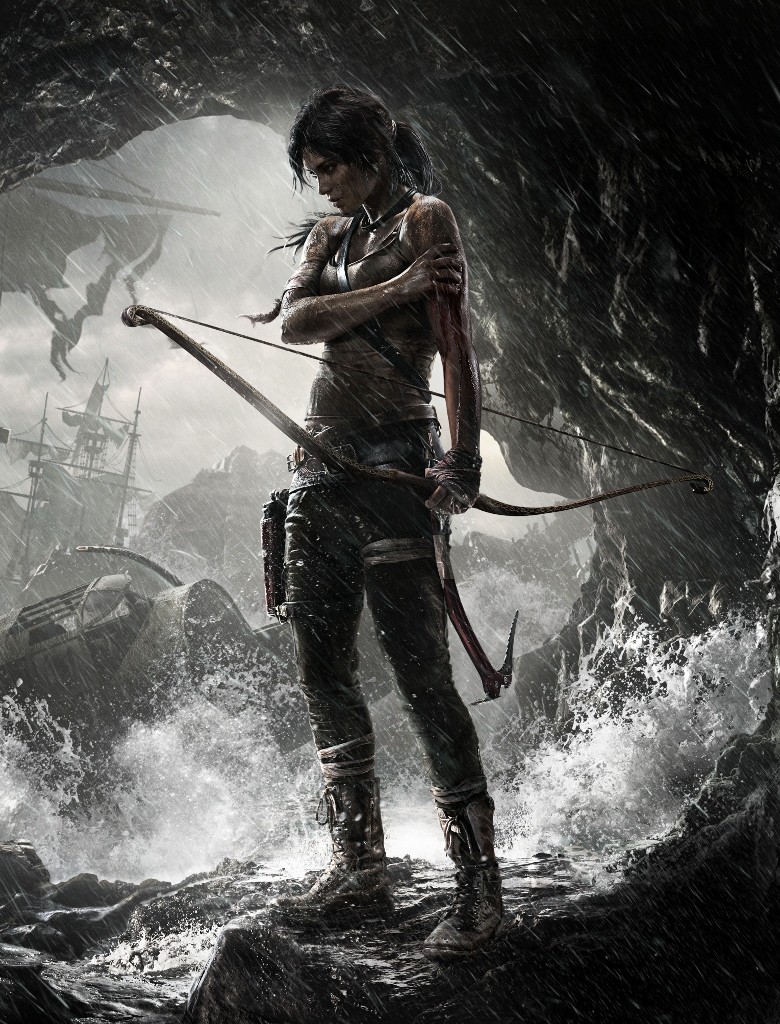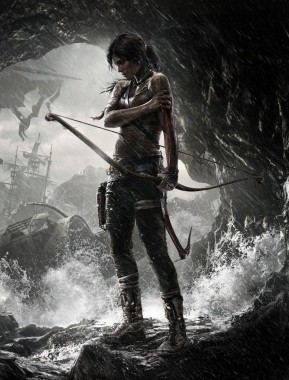
On November 27, I had the privilege of getting hands-on time with the latest build of Tomb Raider, which I wrote about here. But what excited me the most was that I also had the opportunity to hold my first ever interview (which ended up being a 20 minute conversation) with Tomb Raider’s Sr. Art Director, Brian Horton.
A BFA graduate from Savannah College of Art & Design, Horton has worked in the industry for 15+ years. His many duties throughout have ranged from Art Direction, Character/Environment Pre-Visualization, Character Modeling, Environment Art and Story Development, on titles such as Medal of Honor (1999), Marc Ecko’s Getting Up: Contents Under Pressure (2006) and Silent Hill Homecoming (2008). Also an illustrator and fine artist, Horton’s worked on Dark Horse, DC comics and Marvel properties including Batman, Buffy the Vampire Slayer, Star Wars, and The Devil’s Footprints, while his fine art is exhibited in Los Angeles, New York, London and Berlin!
Now that you know the calibre of creative and artistic talent that we’re talking about here, please read the interview and enjoy!
Being the Sr. Art Director, you’ve got a great team of artists that you manage. Of course, being an artist first and foremost, you’ve got your own personal style. Is there any visual element in the game that you look at and can say “that is uniquely my style”? Obviously, there’s not always a place for it…
I would say yes and no. I mean, really, I look at my personal work as my own thing, and we just wanted to make sure whatever we did for Tomb Raider was going to make sense for the game. One thing is, with my work and a lot of the past work that I’ve done in games, I tend to work on 3rd-person action/adventure games. I tend to work on games with a strong sense of character and character growth. And I’ve worked on some games with a good deal of grit and believability, so those are the things that I wanted to bring to bear, that I felt made sense for the game that we were going to make and that’s how I directed Tomb Raider.
As a gamer, before being hired by Crystal Dynamics, did you have your own individual dream or wish for a future Tomb Raider, not knowing that you’d one day get the chance to work on one yourself? And if so, was it at all similar to what has come to fruition now?
I definitely felt Lara was ready to see a more believable treatment; to see what she would look like in that kind of context. So when they pitched it to me as an origin story, and that they were trying to make her as believable as they could, I was like “yes!”; that’s a challenge I wanted to own and work with a team to bring forward. I work with a tremendously talented group: Kam Yu – he’s a long time modeler who’s built Lara for Crystal Dynamics from the beginning – and Bren Adams, the principal concept artist, the three of us teamed up together, and of course Visual Works – the studio that did our trailer – all of us were working on Lara at the same time, trying to develop her. So all of those things came together and I’m really proud of the product that the team’s been able to accomplish.
So Tomb Raider is a gear-gated game, and there are these gameplay hubs we can revisit over time. Could you elaborate on exactly how these are re-encountered by the player; are they open at will for the player to return to at any time, or are they story-driven perhaps…?
We do have a fast travel system that allows you, once you’ve mastered an area, to go back to it. So you will be able to travel back and forth to these hub spaces. There are narrative points by which you re-traverse through a hub space once you’ve progressed and your gear would have been improved and then you’d be able to get to areas that were previously blocked to you. So there are similar structures that you’ll find in a Zelda or Batman game, where there’ll be gear that you haven’t quite acquired yet and you’re like “oh, I see there’s something over there”, and you get that gear and now you’re like “oh man, now I can gain access to that”. So what’s really exciting about that demo you just played is that big mountain hub space – you were just at the very base of it, and you’re kinda overwhelmed, and you get that climbing axe that allows you to ascend higher. That’s just one small example of what that hub has to offer in your multiple visits through there.
I was going to bring this up when talking about your art style, but for those who don’t know, you’ve worked on games like Clive Barker’s Undying, Silent Hill: Homecoming and F.E.A.R. 3, so obviously the survival/horror genres and themes are not new to you. Was there ever a time when the team considered erring more on the side of survival instead of action, in terms of mechanics? For instance, I notice health is regenerative, but was making Lara scavenge for medical supplies and use them to heal ever a consideration?

Yeah, we were definitely considering how best, for example, to deal with health. Where that manifested most was in combat. And what we decided to do was figure out what the best health system was for the combat paradigm we were coming up with. And we wanted a fast paced, fluid combat. You got a little taste of that in the WWII section, where you have that pre-combat stuff where you’re not going to be dealing or dealt much damage and you can stealth your way through and pick these dudes off. But, then you get into that full force combat, and it’s really high paced. We could make you say “Oh, I’ve been damaged, I need to retreat and try to find aid or lick my wounds”, but we wanted you to feel like you were constantly in that battle. So regenerative health was the best answer for that style of combat. But we don’t think it takes away from this survival nature; we still feel like it’s a struggle, that she’s always sort of on the edge of life and death. And there’s so many things in our game that you can collect, that a health resource wasn’t one of those things we thought necessary.
And it just ruins the pace. A more recent example is in Far Cry 2, where you can pull a bullet out or fix a broken finger to heal that wound and your health, but the animation would take so long…but the A.I would barely move too. They could afford to do that. This A.I is aggressive and never affords you that time.
Well, we also wanted to keep people out of pause screens. There’s games like Resident Evil – and I love Resident Evil, I’m a huge Resident Evil fan – but there were moments in those games where you’re in the middle of a fight and you have to enter this interface, and it breaks the tension, it breaks the immersion.
Crystal Dynamics held a Q&A session on Twitter just the other day, and it was mentioned that Lara doesn’t swim in this game. Was that a design decision early on, or maybe a thematic one?
It was a decision on “what do we invest in?”. There’s certain things that we wanted to invest a lot in: into combat, our RPG ingredients, fast travel, we re-did our entire traversal system…there is a LOT of “new” in this game. And what we decided was, “what is really important to this game? What do we need to do?”, and that’s what we stuck with, and the things that we didn’t need to do we would say “wow, it would be great to do, but can we incorporate swimming into our designs” No, we didn’t have a lot of designs that required swimming. It’s one of those things where we’d say “wouldn’t it be neat to at least do surface swimming” or something like that. And as a Tomb Raider fan, swimming means a lot to me…but when it came down to it and you look at the game, it was just one of those things that “fell off the edge”. It was just not a mechanic that was a requirement. But, in the future, if swimming is something that makes sense, I wouldn’t be shocked if we tackled that. It’s not like Crystal Dynamics has never done swimming before, so…
During the puzzles, from what we’ve seen and from what I’ve gotten to play so far, it seems that fire is used quite prominently.
Yeah, in the early go of it, fire is definitely one of our main tools. And it is a primal force and was something that really fit with the theme of survival. It’s the first tool you get, and it’s the first tool in humankind that really “brought us above”. It allows us to cook food, to keep warm…so I think thematically it fit really well, and as a mechanic the idea of acquiring fire worked really well for us. But, in games like these, something that feels like a major obstacle later in the game won’t be. So except to see evolution in that and how fire is used especially.
So, we’ve just touched on this, but do you think you could give us an idea of just how these puzzles evolve?
Well when you think about it, they’re all physics based in some fashion and there’s usually an ingredient; we call it a “survival escape”. Like in the first den, once you solve it…the sh** goes down, and you basically have to get out of there! So that’s part of our formula. Another thing we say is “tinker, not thinker”. We want you to play with the systems, and get an idea of how they work, but not to confuse you to the point where it’s a brain teaser that is going to have you stuck for hours trying to figure it out. So we really wanted to get that sense of play and understanding as the mechanics get introduced to you, and then you get to master those mechanics to solve further puzzles. They tend to be set pieces, and they tend to be things that involve the environment, so environment interactivity is a big part of our puzzle solving.
Something else that was said during the Twitter Q&A was that the game would take about 12 – 15hrs+ to complete. Is this accurate, and if I wanted to do absolutely everything there is to do in the game, how long do you think it would extend that playtime?
I mean, some of the classics could go for 20hrs+, right? But I’d say, in modern gaming though, it’s a long adventure. It definitely is up there with some of the more top-notch 3rd-person action/adventure games. So I’d say from a blanket perspective, we’re not sure. We’re not the longest game, but if you’re an explorer and you really want to be a completionist, you can easily put in 20hrs.
I hate to bring up Uncharted for obvious reasons, but those games would take only 8-12 hours to finish, and people were absolutely fine with that because it was a story-focused game, much like Tomb Raider, and it was told well and succinctly.
Yeah, it’s a good 10hr game. And I think, when you’re building this kind of premiere content where it’s very heavy on the experiential side of things – those are expensive minutes, as we call them – how much development money do you have to put into those minutes? But, there’s enough systemic gameplay in there that we were able to bulk it up and tell a really rich, cinematically driven story, while also giving you a lot of freedom and choice.
Is it fair to say that by the end of the game, Lara will develop to be closer to the Lara we’ve known from previous titles?
I think it’s fair to say that this is a re-imagining, just like when you look at what they’ve done with Bond – it’s not going to be the same Bond or stories that Sean Connery did. It’s going to be new, but it’s the spirit of the franchise that we’re retaining.
One thing I’ve wondered since we first saw footage of the game, is whether or not you will come across conflict in your travels from objective to objective. I’ve seen that Lara will have to contend with and avoid wolves as she moves throughout. But are the mercenaries we’ve seen found throughout, roaming around or maybe set up at outposts?
There’s definitely enemy combatants that are going to be in and amongst regular traversal areas, and there’s also going to be areas that are set pieces made for combat, and what you saw in that demo today was sort of a mix of both. You’re ascending the mountain, you come up to this way-point where these dudes are hanging out as this storm is coming in and they’re like “should we wait out the storm? Let’s get under the shelter”. And that wasn’t one of the set-piece places, but it gave you an opportunity to sort of see how these enemies can be scattered all throughout the island, and in different numbers. So there’s concentrations of enemies, like in the WWII base that you saw, and then there’s instances where they’re just scattered about from here to there.
This final question is centered around something I know many Tomb Raider fans are wondering: since this is a gritty, realistic take on Lara Croft, but we have seen some very early concept art speak to the contrary, are the supernatural elements less prevalent here? I know they haven’t been excised completely after today’s demo, with references to a Sun Queen named Himiko, etc…
Yeah, I can definitely tell you that it’s a Tomb Raider game, and that formula includes something of a mystery, something that’s not quite normal. And that’s definitely an ingredient that we played with, that you picked up on with the myth, and the Yamatai story, that there is something about this island that is larger than it initially seems. Even just looking at those shipwrecks, you think “what would cause this?!”. So I think for the fan that is unsure from the footage that’s been shown so far, just know that they should be happy and there is a classic treatment intact. Now, to the degree that we go; I will tell you that we don’t have T-Rex’s either.
[Laughter] Of course, of course…well thank you so much for your time, it was an honor to hold my first ever interview with someone of your stature who is working on such a high profile game. So we can expect Tomb Raider on March 5th, for the PS3, PC and Xbox 360. Is that a global release date?
Yes, I believe that will be a global release date. I’m really excited that you’re happy about it. It was great talking to you!
Absolutely, I’m looking forward to it. Thanks Brian!



